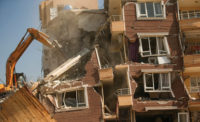The aftermath of the Feb. 6 earthquakes and aftershocks in central Turkey has begun to shift from immediate search-and-rescue efforts to a grim cataloguing of the extent of the destruction, with emergency response teams in Turkey and Syria beginning the work of evaluating the condition of thousands of buildings and infrastructure impacted by the temblors.
The extent of the damage is vast. With over 28,000 dead and many more now homeless, the humanitarian need is real. But response efforts have been hampered by damage to critical infrastructure. In Turkey, three airports are shut down, including Hatay Airport closed due to severe cracking in its asphalt runways due to the quakes.
Mersin, Turkey’s third biggest container port, and Iskenderun, its seventh, saw fires rage for two days and have suspended operations. There are fears priceless monuments may have been destroyed as well. Turkey's historic Gaziantep Castle's stone walls cascaded down the sides of the fort in Gaziantep.
Historic sites in Aleppo and Latakia were damaged in Syria, where the Ministry of Transport has suspended all rail traffic to check the condition of rail lines. Turkey's Anadolu Agency said the Ministry of Transport and Infrastructure stated many rail lines had been damaged, with 446 bridges, 6,161 culverts and 175 tunnels on rail lines affected.
“The Turkish government has been preparing for an event like this for quite a long time,” notes Kit Miyamoto, head of U.S.-based engineering firm Miyamoto International. “But this is a widespread area that was affected, due to the distance between [the magnitude 7.8 and 7.5] epicenters.”
Miyamoto, whose firm often responds to global disasters zones in need of engineering expertise, is now in Turkey, working with local engineers and in cooperation with the World Bank on how best to go about evaluating buildings for occupancy and working out a path toward repairs and rebuilding. The World Bank announced Feb. 10 that it was allocating $1.78 billion toward recovery and reconstruction efforts in Turkey and Syria following the earthquakes. Of that amount, $780 million will be made immediately available through existing programs.
Before heading to Turkey himself earlier this week to inspect the damage, Miyamoto told ENR that Turkey's modern seismic building codes should be credited for keeping many buildings standing through the earthquakes.
But uneven enforcement and implementation of those codes across the country is a real problem. “Turkey’s building codes were changed in 1997 to seismic code similar to California…the building codes are solid, some really good ideas,” he says. Subsequent updates to the codes have tightened seismic standards further, but there are gaps.
The uneven implementation of the codes is already being seen in initial surveys of building damage by Miyamoto International's Istanbul office. “Our engineering team estimates the collapsed buildings at 7,000, and it could be 10,000 or more. About 10% or more of that is new construction, modern construction, still following the old standards.”
In fact, lack of structural integrity, transparency, contractors cutting corners and poor implementation of seismic codes are likely causes for much of the damage, several experts told ENR in the days after the quakes.
One key point is that Turkey’s buildings date from different eras. “A huge [portion of the] building stock does not obey any code. That's why some buildings are operational, and some collapsed,” Aras Kalyoncuoğlu, senior structural engineer at PROMER Consultancy Engineering, Istanbul, told ENR.
While some structures survived the first main shock and performed as designed, with controlled damage and collapse prevention, “No design code considers two sequential main shocks in two very close fault zones,” said Kalyoncuoğlu. The fatigue due to the first earthquake could have reduced the ductility performance of structures, he says.
“The government has already allocated $5.5 billion in resources to organizations, but we should see the exact damage first…and wait for search and rescue work to end. Once AFAD [Turkey’s disaster and emergency management agency] provides earthquake ground motion data to complete the survey, we will be able to estimate if the design code is enough or not,” Kalyoncuoğlu said.
But what will happen with new construction after the facts are in is still uncertain. “Earthquakes return after a long time, and people have short memories…[we must] take strict precautions against the earthquake in this zone,” he said.
Miyamoto concurs on the need to take action on reforms and enforcement while the memories are still fresh. “There’s a five-year window,” he says, citing other natural disaster recovery efforts his firm has worked on. “After bad things happen, you have about five years to do things, but then it closes—people lose interest.”






Post a comment to this article
Report Abusive Comment